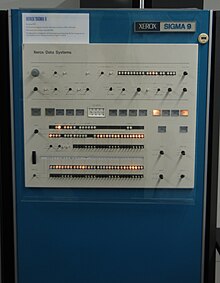 Living Computer Museum - Xerox Sigma 9 Living Computer Museum - Xerox Sigma 9 | |
| Developer | Xerox |
|---|---|
| Product family | Xerox Sigma |
| Release date | 1970 |

The Xerox Sigma 9, also known as the XDS Sigma 9, is a high-speed, general purpose computer.
Xerox first became interested in office automation through computers in 1969 and purchased Scientific Data Systems or SDS. They then renamed the division Xerox Data Systems or XDS; they saw limited success, and the division was ultimately sold to Honeywell at a significant loss.
The Sigma 9 was announced in 1970 and the first delivery was made in 1971. There were 3 models built, the Sigma 9, the Sigma 9 Model 2 and the Sigma 9 Model 3. The original was the most powerful and was universally applicable to all data processing applications at the time. The Model 2 was able to process in multi-programmed batch, remote batch, conversational time-sharing, real-time, and transaction processing modes. The Model 3 was designed for the scientific real-time community.
Features of the Basic Systems
All models featured a CPU with at least a floating-point arithmetic unit, Memory map with access protection, Memory write protection, Two real-time clocks, a Power fail-safe, an External interface, Ten internal interrupt levels. Also a Multiplexor input/output processor (MIOP) featuring Channel A with eight sub-channels.
Listed below are the individual specifications
Sigma 9
- CPU featuring:
- Decimal arithmetic unit
- Two 16-register general purpose register blocks
- Interrupt control chassis with eight external interrupt levels
- Memory reconfiguration control unit
Model 2
- CPU featuring:
- Decimal arithmetic unit
- Two 16-register general purpose register blocks
- Interrupt control chassis with two external interrupt levels
- Main Memory of 32K words
Model 3
- CPU featuring:
- One 16-register general purpose register blocks
- Interrupt control chassis with two external interrupt levels
- Main Memory of 32K words
References
- "Exhibits - Living Computer Museum". www.livingcomputermuseum.org. Retrieved 12 July 2016.
- "Sigma9 Sales Guide" (PDF). Retrieved 12 July 2016.
- Xerox Sigma 9 Reference Manual. El Segundo, California: Xerox. June 1972.
Further reading
- Sigma 8, 9 Withdrawal Pains Eased With Independent Memory. (1979). DM, Data Management, 17(2), 24.
| Xerox | |||||||||
|---|---|---|---|---|---|---|---|---|---|
| Founders | |||||||||
| Corporate Directors |
| ||||||||
| Divisions |
| ||||||||
| Hardware products |
| ||||||||
| Software products |
| ||||||||